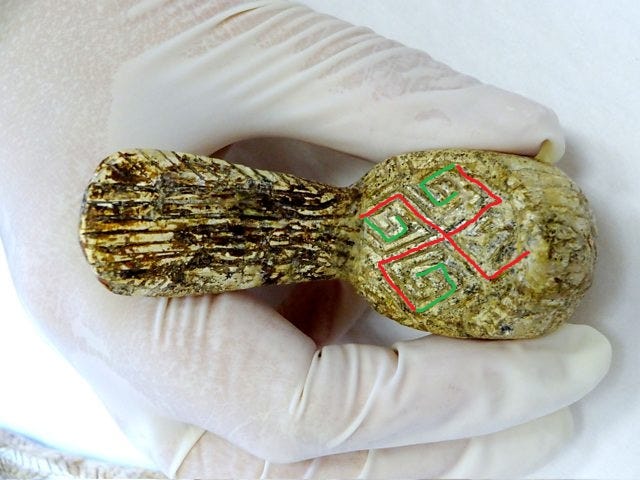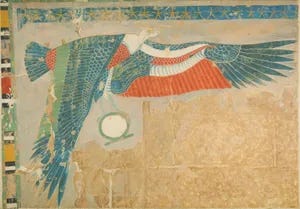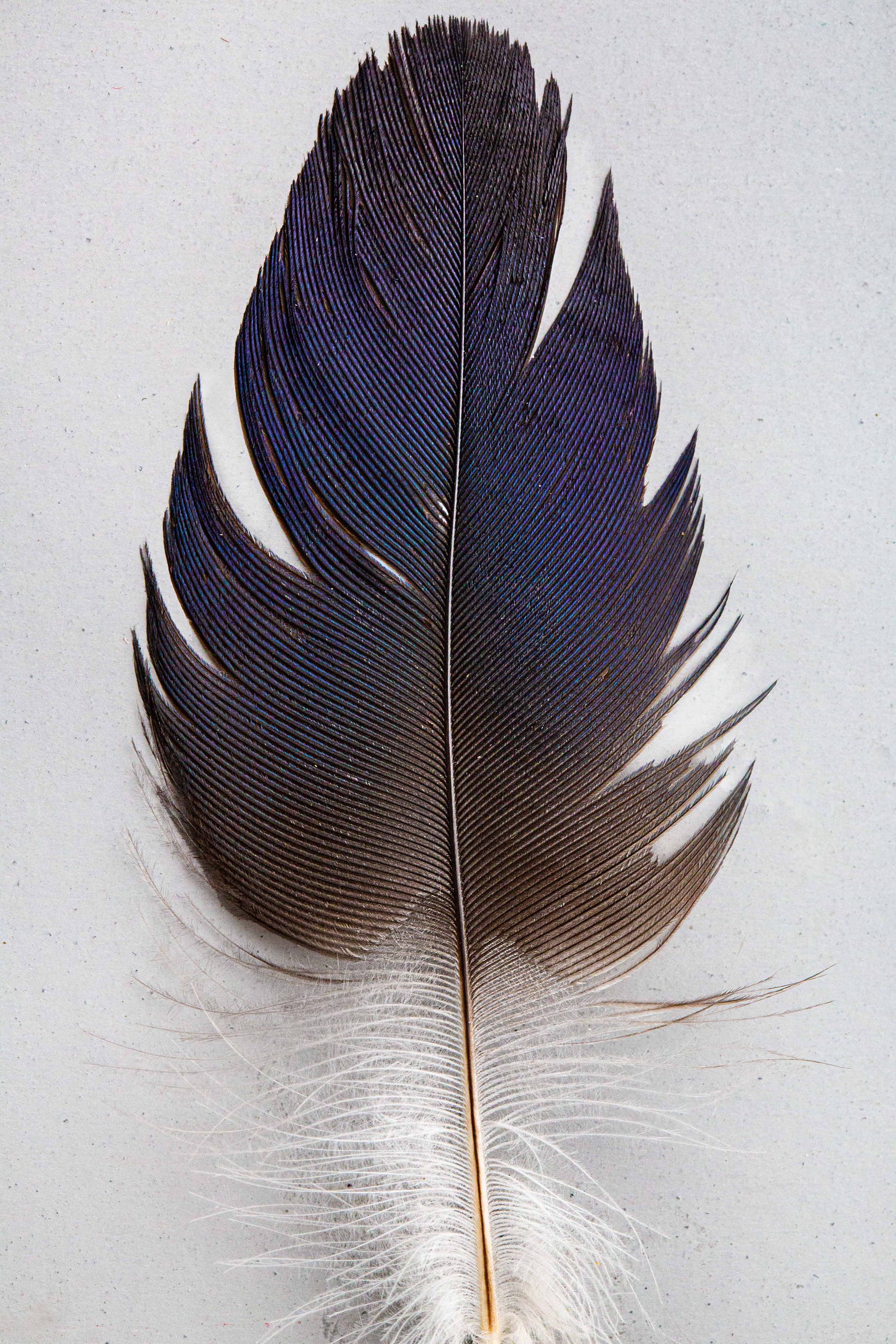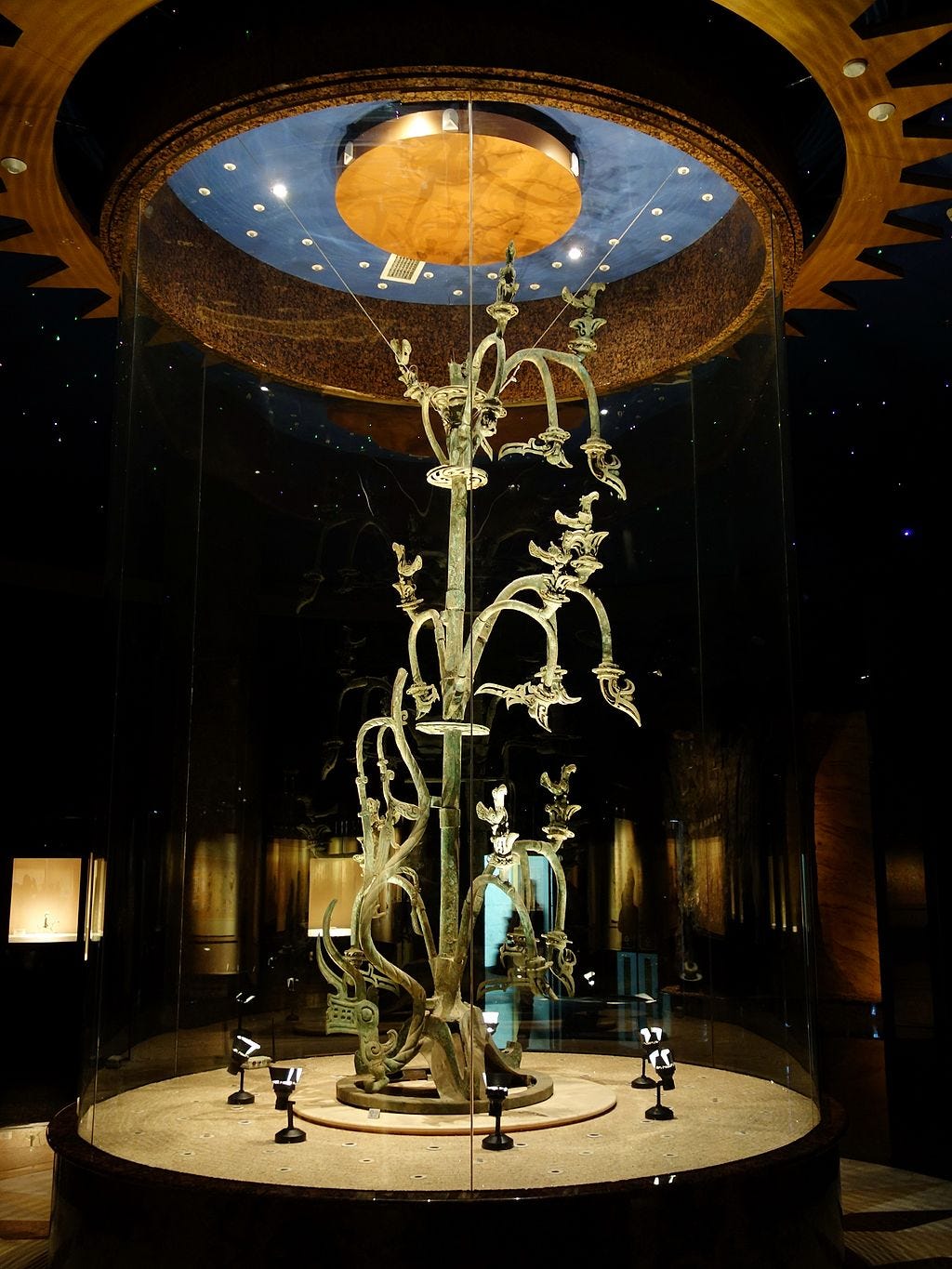MissTree of the Alchemical Woman (Part 3)
The bird, as a regenerative icon at the roots of the symbolism of the Tree of Life
This is a continuation of the breakdown of the symbolism of the Tree of Life (can read Part 1 and Part 2), through the regenerative trope. Here, in Part 3 we dissect the bird iconography. I can’t help but think of the relationship between the bird and our prehistoric ancestors; the symphony of music upon rising with the sun, as the birds sing to usher in a new day and likewise greet nightfall. Could the birds have taught us how to sing, to create a melody, music and later, develop a language of sounds and meaning of our very own? If you pay attention while out in the wilderness, you can usually know if a predator is coming your way, by the early warning call of birds, followed by the flutter of a flock in the opposite direction. Did the birds teach us which berries were safe to eat, or how to knit and weave bark and grasses together? Birds are more than symbols, but omens. In fact, the Greek word for bird is órnis (ὄρνις) or oionos from which we derive the word “omen”. Even to this day, I’m sure in the event you find a feather on your path, you quickly google what it means according to the colour or type of bird it came from.
Putting aside all these questions about the potential relationship between early Homo sapiens and birds, let’s get a little sticky beak into the symbolism that resulted from such an alliance.
A terracotta Siren from Greece, 300 BCE, shows the creatures in their original, bird-woman form. Photo: Peter Horree, Alamy
In many cultures, birds are psychopomps, transporting the spirits of the dead to the Afterlife. In ancient China, there was the belief that the cranes conveyed the souls of the dead. Whilst, in Egypt, we have the concept of the “ba”, the soul in the form of a bird, often depicted as a bird with a human head. In the Book of the Dead, it is illustrated as the ba flying out through the doorway of the tomb. Similarly, in Greece, we find the earliest depictions of the singing sirens with the body of a bird and the head of a woman, which often appeared decorating the tombs and funerary texts. No doubt the shrieks and cries of birds of prey must have sounded like the mourning squeals of women in a burial procession. Likewise, in the Hellenistic world, the dove was a symbol of the soul and there was often imagery of it flying out of the mouth of the dead. Harpies, meaning snatchers or swift robbers, were another bird-woman character in Greek myths, said to steal food from evildoers and act as agents to the gods, in guarding the Underworld. Further north, we find this trope in Norse mythology, with the Valkyries - supernatural women who would fly over the battlefield, sometimes accompanied by ravens or often shapeshifting themselves into swans, acting as guides for the souls of those slain in battle. These beliefs may be rooted in primordial traditions of sky burials or excarnations, whereby the corpse was placed on a raised mound or platform for a few days before burial; to allow for scavenging birds like owls, vultures, eagles, hawks and corvids to strip away the flesh and organs, leaving only the bones. Once excarnated, the bones would be collected for the burial ceremony, intentionally laid out in the foetal position, and covered in red ochre, in reference to the symbolic return, entombed through the womb of the Great Mother.
Stylized female figurine of mammoth tusk from Mizyn. 15 000 BP, Late Palaeolithic.
The National Museum of the History of Ukraine in Kiev. © Culture Wise Productions
The bird is one of the oldest emblems found as far back as the Upper Palaeolithic Era. In fact, the earliest known example of the swastika symbol was found on a bird figurine, carved from mammoth ivory, dated to approximately 15,000 years ago (i.e. during the last Ice Age), found in Mizyn, Ukraine. Around the same timeline, we find a clear silhouette of a bird on a stick, painted on the cave wall in Lascaux, France.
Lascaux cave paintings, Southwest France, discovered in 1940, dated approximately 18,000 years ago, seems to be documenting a shamanistic ritual.
The “Bird Goddess” is perhaps one of the oldest representations of the archetypal fusion of the woman and the bird. Numerous beaked “Venus” figurines have been unearthed dating as far back as the Upper Palaeolithic. The bird goddess often depicted with a woman’s body, delineated with drooping breasts and wings and with a bird mask/head, perhaps alluding to early shamanism, dressed in feathered capes, bird mask or feathered headdress. This anthropomorphic bird goddess pervades the Copper (Chalcolithic Period) and early Bronze Ages, found in examples such as spindles (weaving tools), pendants, jewellery, pottery and other artworks, with the “V” shaped head and double chevron patterns, perhaps derivative of the triangular shape of most beaks or symbolically hinting to the vulva, the pubic triangle of woman.
Flocks of migrating birds fly in “V” formation, to conserve energy for aerodynamic efficiency in long distance travel. Photo via National Geographic.
Female Figure - Naganda “Bird Lady, Egyptian Predynastic Naganda lla ca. 3500–3400 B.C.E.. Clay, pigment, 11 1/2 x 5 1/2 x 2 1/4 in. (29.2 x 14 x 5.7 cm). Brooklyn Museum, Charles Edwin Wilbour Fund, 07.447.505. Creative Commons-BY (Photo: Brooklyn Museum, 07.447.505_front_SL3.jpg)
We find many examples of the bird goddess later on in Egypt as well, in the form of the vulture, kite or falcon. In fact the hieroglyph for “mother”, “motherhood” and “compassion” were all symbolised by the “vulture 𓅐” pronounced “mut” and its origins can be traced far back in prehistory. The vulture was associated with the goddesses Mut and Nekhbet, who were both icons of motherhood, fertility, protection and in the case of Nekhbet, also linked to the dead. Mut was a primordial deity, a parthenogenetic goddess, because Egyptians believed vultures were born parthenogenetically (in fact, the Californian Condor are known to procreate without males). The vulture, particularly, was one such bird that was most recognised as a symbol of transformation, for it does not kill, it awaits death and transforms “it” by consuming the flesh, taking it into itself and transmuting it in rebirth via the primal egg.
The Goddess Nekhbet, Temple of Hatshepsut The Goddess Nekhbet, Temple of Hatshepsut, tempera on paper by Charles K. Wilkinson for the Egyptian Expedition of the Metropolitan Museum of Art. This is a 20th-century facsimile of a painting created c. 1479–58 bce at the Temple of Hatshepsut, near Luxor, Egypt.
A feather gifted by Mr Crow (a wild crow I hand feed - that’s another story for another day). The individual feather with its central pole, much like the axis symbolism of a tree or a fully extended snake. Similar to the tree, the feather has numerous branches reaching out like a flame. Maybe this is where we get the imagery of the mythical firey phoenix.
I can’t fail to not mention Ma’at with the ostrich feather above her head, symbolic of the “weighing of the heart” in the Egyptian death rites. However, death is only one aspect in the circle of life. Birds are the only living creature covered in feathers and just like snakes shed their skin and trees drop their leaves, birds also go through seasonal molting, loosing their feathers and regenerating new ones. Once again, we see the theme of regeneration echoed in the bird. Just as the ancient Egyptians observed that twice a year, flocks of birds few over North Africa, in their migration to and from the European continent, signalling the changing seasons of death and renewal. In European folklore, they associated the migratory return of the storks in spring, with them delivering babies to families, which they believed the birds retrieved the unborn souls from caves and marshes. Storks interestingly are carrion- eaters, which may once again be referencing the primordial tradition of excarnation. However, the legend of the storks perhaps more likely coincided with the pagan fertility traditions, in which couples would copulate in celebration of the Summer Solstice and 9 months later, which would fall exactly around mid March, would see an influx of newborn babies.
Venus de Lespugue This 6-inch high sculpture of tusk ivory was discovered in 1922 in a cave in the Pyrenees in present-day Southern France. It dates to 24000-22000 BCE, well before any known system of writing had been established.
Birds and snakes don’t just have a shared evolutionary connection (birds having evolved out of the reptilian species) but they also share in the egg symbolism. We addressed previously that most snakes lay eggs like birds, drawing on the twice-born iconography of the egg. The egg belongs to the female. We can see the egg symbolism carry over into the double-egg shaped buttocks of the Upper Palaeolithic and Neolithic “Venuses”, which Gimbutas has inferred was a metaphor of the double egg or pregnant belly. She postulated that duplicity in ancient art was to intentionally intensify the significance, in this case, of fertility, the life giving aspect of the woman/ creatorix.
The Burney Relief is hotly debated amongst academics as to whether this is a depiction of Inanna/ Ishtar or Lilith. Old Babylon 19th-18th century BCE; British Museum via Wikipedia
Owls, another bird of prey, are most famously associated with the Greek goddess Athena - the goddess of wisdom, war and weaving. Owls are one such bird often found decorating spindles and whorls used in weaving, just as birds knit twigs and branches together. In ancient times, the act of weaving was believed to be the act of incarnating a soul. Perhaps though, the bird most renowned for resurrection is that of the phoenix. This fabled bird can be found in ancient Egyptian mythology via the Bennu bird (a type of heron), which was an ideogram for the sun god Ra’s cycle of death and rebirth, believed to combust and rise again from its ashes. Fenghuang, the legend of the Chinese phoenix is often portrayed alongside a dragon and a tree of life, reiterating this concept of cyclical renewal. In fact, archaeologists discovered 3 bronze sculpted trees, one with a dragon at its roots and a bird like creature on the top of the tree, uncovered from a sacrificial pit. This artefact feels pretty reminiscent of the Anzu bird nesting in Inanna’s Huluppu Tree or the Víðópnir bird sitting atop the Yggdrassil Tree.
Bronze Tree with birds, flowers, serpentine dragon and ornaments from Sanxingdui, dated to about 1200BCE, via Wikipedia
In summary, we have seen how the bird is one of the earliest totemic forms of the creatorix, via her anthropomorphic shape, as the womb from which life springs forth and returns upon death. Her protective wings embrace us through the circle of life, as the bird traverses both the heavenly and earthly realms. It is here I’ll wrap up my weave on the regenerative symbolism of the three icons: the tree, the snake and the bird, all allegorical guises of the mother of life and death. In Part 4, I’ll look at all 3 icons through their oracular symbolism, which is another element of the divine feminine.
Thank you once again for your time in exploring with me, as I research and teach myself on these topics and feel free to comment with any further references and interpretations, as I am always open to expanding my perceptions.
BIBLIOGRAPHICAL SOURCES
Lady of the Beasts (Ancient Images of the Goddess and Her sacred animals) by Buffie Johnson
The Woman’s Encyclopedia of Myths and Secrets by Barbara G Walker
The Woman’s Dictionary of Symbols and Sacred Objects by Barbara G Walker
The Language of the Goddess (1989) by Marija Gimbutas
The Great Cosmic Mother - Rediscovering the Religion of the Earth by Monica Sjöö and Barbara Mor
















I enjoyed this breakdown particularly because I was having a hard time connecting birds and women — super interesting to learn about vulture symbolism and the etymology of the word bird. Great stuff 👏🏽👏🏽 Excited for part 4!
Thank U 🙏🫶